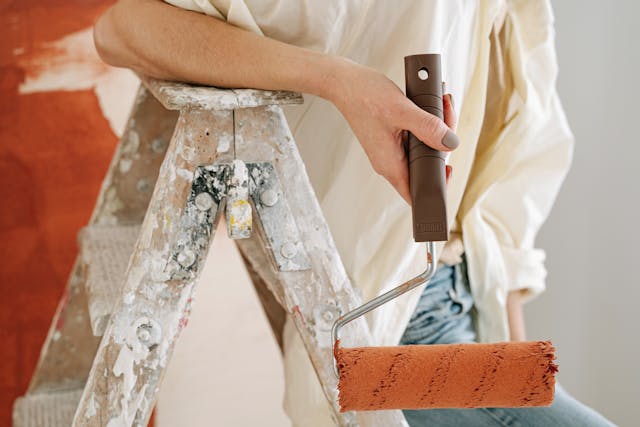
Keeping your property in good condition is essential for maintaining its value and appeal to tenants. Regular maintenance, repairs, and upgrades are key, but deciding whether to let tenants paint can impact both their experience and your property’s condition.
While allowing painting can personalize the space and improve tenant satisfaction, it also poses risks like unexpected costs or property damage. To make the best decision, weigh the pros and cons, set clear guidelines, and ensure your choice aligns with your long-term goals.
Advantages of Permitting Tenants to Paint
Strengthens Your Landlord-Tenant Relationship
Allowing tenants to paint can improve the overall relationship between you and the tenant. Tenants often feel more at home when they can personalize their living spaces. It helps foster goodwill and may make them more likely to renew their lease or take better care of the property.
Encourages Tenants to Take Responsibility for the Property
When tenants are given the freedom to paint, they may feel a stronger sense of ownership over the property. This could lead to them taking better care of the space, as they may view it as their own to some extent. It can also encourage tenants to maintain the property in better condition, as they may want to preserve the improvements they have made.

Offers a Competitive Edge in the Rental Market
In some cases, allowing tenants to make cosmetic changes can make your rental advertisement stand out in a competitive market.
Some renters may prefer a property where they can express themselves through design. It adds an extra layer of appeal, particularly in areas where tenants are accustomed to having some level of control over their living spaces.
Justifies Higher Rental Rates
If tenants are allowed to make their living spaces feel more like home, it could make them more willing to pay higher rent. They may be more satisfied with the property if they can customize the walls or rooms. As a result, they may be more willing to agree to higher monthly rent, especially if they feel the property meets their personal preferences.
This can result in an increased rental income without a significant investment on your part.
Disadvantages of Permitting Tenants to Paint
Potential Disputes
There is always the potential for disagreements about the quality of the work done or the choice of colors. Some tenants may want to change their minds after painting, while others may feel that the job wasn’t done correctly or to their satisfaction.
This can lead to conflicts that may require additional time, effort, and even legal involvement. The last thing you want is for a disagreement about paint to escalate into a larger issue.
Increased Expenses
Allowing tenants to paint may result in additional costs for you as the landlord. If the tenant doesn’t follow guidelines or does a poor-quality paint job, you may need to re-paint the space when they move out.

Even if the work is well done, there could still be costs associated with restoring or touching up areas when the tenant moves out, especially if they did not follow the terms of the agreement.
Ongoing Maintenance Issues
Paint can wear out over time, especially in high-traffic areas. Allowing tenants to paint may mean that they choose colors or paints that are harder to maintain. Some types of paint may stain easily or require more frequent touch-ups.
Additionally, if tenants do not follow proper preparation processes (like sanding or priming), the paint may not last as long as it should, resulting in a need for more frequent maintenance and repairs.
Guidelines for Allowing Tenants to Paint
If you decide to allow tenants to paint, it’s crucial to establish clear guidelines upfront to avoid potential issues down the road. Here are key elements to include in your guidelines to ensure clarity and consistency:
1. Restoration Clause
It’s essential to include a restoration clause in your lease agreement that outlines the tenant’s responsibility to return the property to its original condition when they move out. The clause should specify that the tenant is required to repaint any areas that were altered or restored to the original color before vacating the premises.
2. Clearly Outline Boundaries
Be clear about which areas the tenant is allowed to paint. For example, you may permit them to paint their bedrooms, but not the kitchen or hallway. Make sure that the tenant understands any restrictions and agrees to only paint the designated areas. This helps to keep the property looking uniform and prevents unauthorized changes to areas that should remain neutral.

3. Pre-approve Colors
Ensure that the tenant’s chosen colors are compatible with the rest of the property. You don’t want a bright red or neon green room when the rest of the house is painted in neutral tones. Agreeing on color choices before they begin will help prevent any misunderstandings and ensure the result complements the property’s aesthetic.
4. Suggest or require the use of professional painters
While some tenants may have painting skills, it’s often a good idea to suggest or require professional help for larger or more complex jobs. A professional painter will ensure that the job is done properly, using quality materials and techniques. This can save you time and effort in the long run, and you can be confident that the paint job will last.
Bottom Line
Allowing tenants to paint your rental property has pros and cons. It can boost tenant satisfaction, enhance appeal, and justify higher rents but may lead to challenges like additional costs, disputes, or loss of control over the property’s look. Clear guidelines and careful evaluation can help balance these risks.
Do you need help managing tenant requests or maintaining your rental? Vesta Property Management offers expert guidance and solutions to keep your property in top condition. Contact us today to learn more!